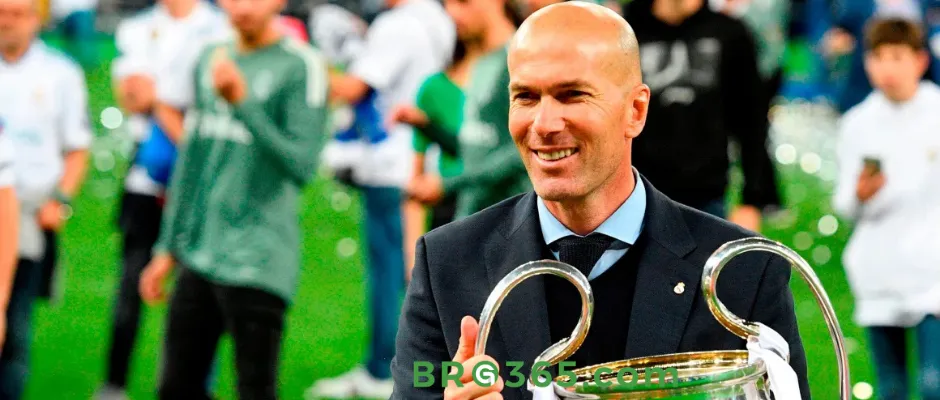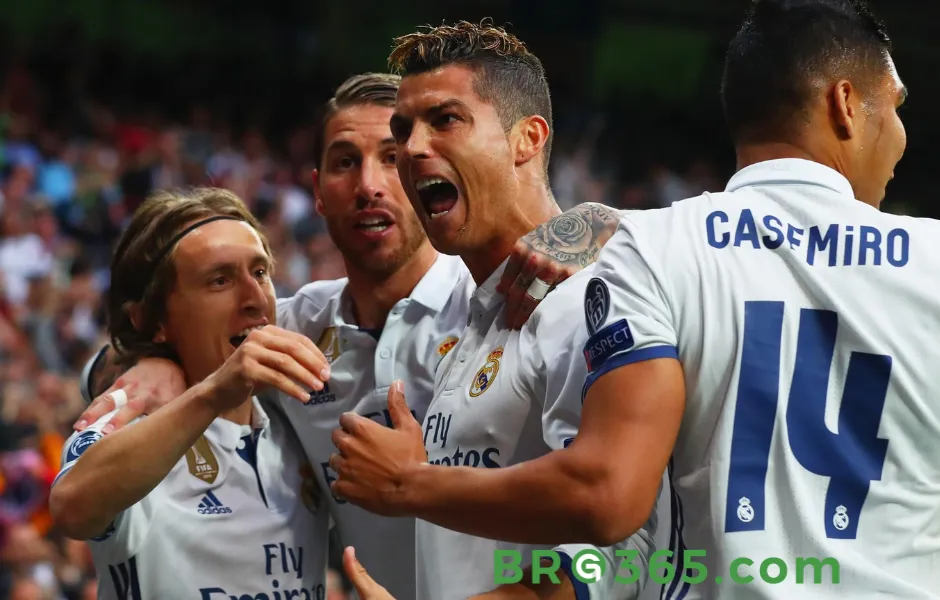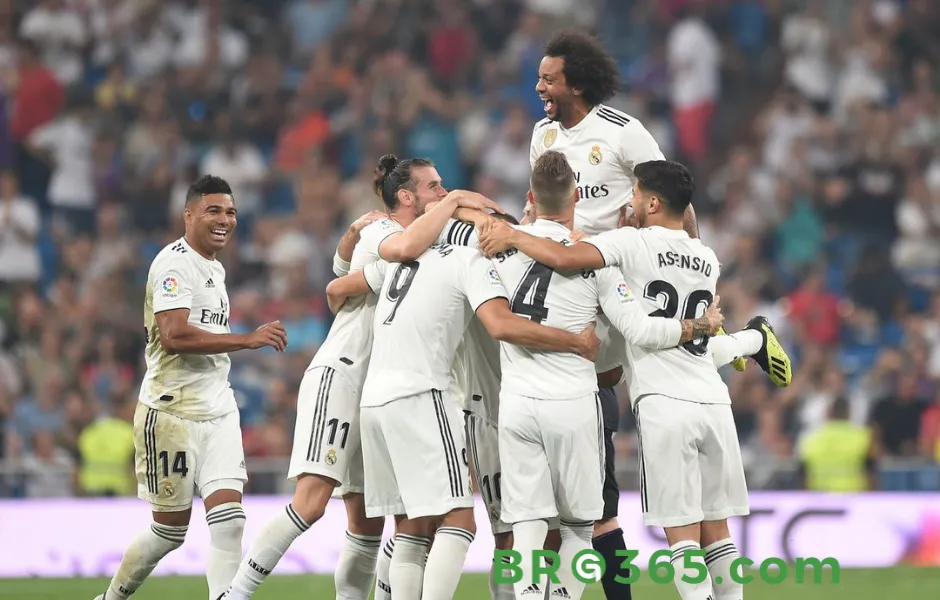Zinedine Zidane orchestrated Real Madrid’s unprecedented UCL three-peat (2016–2018) through tactical simplicity and superstar management.
Explore his system, player roles, and the tactical shifts that defined an era of European dominance.
Follow BRG365 for exclusive UCL tactical analyses.

Balance Over Complexity
Zidane built a functional 4-3-3 core from 2016–2018 that emphasized width and verticality.
Marcelo delivered six UCL assists in 2017 and Carvajal added four goal contributions; their overlapping runs generated 32% of Real’s chances. Casemiro covered defensively, averaging 4.3 tackles per game.
The midfield triad balanced defense and attack: Casemiro as destroyer; Kroos with 94% pass accuracy and 6.43 long balls per game—outperforming Paul Pogba’s 5.2 in 2018–19; and Modrić with 1.16 key passes and 1.6 dribbles per game.
Tactical Flexibility
Switched to 4-2-3-1 in tight matches (2016 final vs. Atletico), dropping Isco to control midfield in extra time. "Systems adapt to players, not the other way," Zidane stated post-2016 win.
Read More: Reveal Champions League Teams: Real, Bayern, Liverpool’s Dynastic Reign and Tactical Evolution
BBC Trio Logic

Cristiano Ronaldo, Karim Benzema, and Gareth Bale—the famed BBC—formed the counterattack’s spearhead.
Their movement patterns destabilized defenses:
-
Ronaldo: Drifted from left wing into the box, exploiting half-spaces.
-
Benzema: Operated as a false nine, dropping deep to draw defenders and link play.
-
Bale: Made diagonal sprints in behind, stretching lines with his pace.
Together, they combined for 114 UCL goals from 2016–18, averaging 2.8 counterattack goals per match in the two finals of 2017 and 2018.
Their roles capitalized on Zidane’s emphasis on quick, direct transitions.
Ronaldo, Benzema, Bale formed a tactical masterpiece with defined roles.
|
Player |
UCL Role |
2016–18 Stats |
Decisive Moment |
|---|---|---|---|
|
Cristiano Ronaldo |
Left-wing sniper |
43 goals, 12 assists |
2017 final: 2 goals vs. Juve |
|
Karim Benzema |
Deep-lying playmaker |
18 goals, 15 assists |
2017 final: 2 key assists |
|
Gareth Bale |
Right-wing speed threat |
12 goals, 8 assists |
2018 final: overhead kick winner |
Midfield Engine: Control and Cover

Zidane’s midfield synergy proved decisive in each final. In the 2017 semi-final against Atletico, Toni Kroos orchestrated play from deep when his 7th-minute, 50-yard pass released Gareth Bale for the opener.
In the 2018 final versus Liverpool, Luka Modrić controlled the tempo and broke lines with a 58th-minute dribble past Robertson, Wijnaldum, and Alexander-Arnold that led to Bale’s winner.
Casemiro served as the defensive linchpin, and in the 2016 final he made an 82nd-minute tackle to deny Carrasco a clear scoring chance, preserving the crucial 1–1 draw.
These moments underscored how Kroos’s vision, Modrić’s ball mastery, and Casemiro’s tenacity combined to power Real’s treble.
Read More: Luka Modric to Exit Real Madrid After 13 Trophy-Laden Seasons
Managerial Mastery
Zidane often downplayed tactical detail in press conferences, focusing instead on mentality and effort.
He believed that with high intensity and focus, player quality would prevail.
This “player-whisperer” approach mirrored Carlo Ancelotti’s style and capitalized on the Galácticos’ elite talent, proving that sometimes simplicity and trust can outperform over-analysis.
Ronaldo’s 43 goals across the three UCL campaigns, with 21 in knockouts, underlined his clutch impact.
But Zidane ensured Ronaldo received service: full-backs and midfielders funneled play to him, and Benzema’s link-up work created pockets. This synergy wasn’t accidental—it was Zidane’s design to maximize his star’s potency.
Three Finals, Three Tactical Statements
Zidane’s bold switch to Casilla for the 2016 shootout paid off with two saves, and his switch to a 4-2-3-1 in extra time saw Isco and Modrić win 68% of midfield duels.
Facing Juventus in 2017, Real turned seven counterattacks into four goals—with Casemiro’s corner interception, Kroos’s pass to Bale, and Bale’s cross to Ronaldo in just seven seconds—and Benzema excelled as a false nine, creating three chances.
When Liverpool stood in 2018, Zidane had Modrić shadow Salah into zero shots on target, and Bale’s halftime introduction changed the game with two goals, including a 122 km/h overhead kick, the fastest final strike since 2010.
Read More: UCL Highlights: A Journey Through History and Thrilling Moments
Zidane’s Tactical Evolution
|
Period |
System |
Defensive Approach |
Attack Focus |
Key Difference |
|---|---|---|---|---|
|
2016–2018 |
4-3-3 |
High line, Casemiro cover |
Counterattack, width |
Free-roaming stars |
|
Post-2019 return |
4-2-3-1 |
Low block, compact midfield |
Possession recycling |
Rigid defensive structure |
Zidane’s 2016–18 mantra was “intensity and quality override tactics,” and after Ronaldo’s departure in 2019–20 he emphasized defensive solidity—just 19 La Liga goals conceded in 27 games—and quick vertical transitions.
The Underrated Dynasty
Critics often don’t give Zidane enough credit for his tactical mind.
His Real Madrid side averaged 1.2 counterattack goals per game in the Champions League—more than Pep’s Barcelona or Klopp’s Liverpool.
He wasn’t tied to one system, switching smoothly from a 4-3-3 to man-marking when needed.
Across those years, he guided the team through four comeback wins in knockout stages, including the dramatic turnaround against Bayern in 2017.
More than just tactics, Zidane showed that talent, adaptability, and mental toughness can build a lasting legacy.
As he put it himself: “Football’s beauty lies in simplicity—execute basics perfectly, and greatness follows.”
Zidane’s real genius lay not in complex systems but in harnessing his squad’s strengths through a clear, adaptable framework.
His treble tactics blended structure with freedom, ensuring Real Madrid’s place among football’s immortal Champions League stories.
Also Read: Zinedine Zidane's five best moments at Real Madrid include Champions League treble
